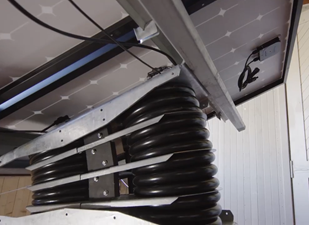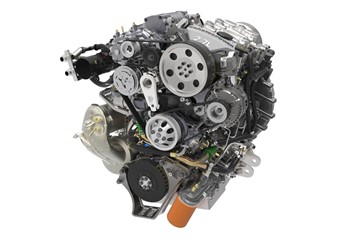
Turning Ideas Into Reality – Projects in Progress XII
ARPA-E focuses on next-generation energy innovation to create a sustainable energy future. The agency provides R&D support to businesses, universities, and national labs to develop technologies that could fundamentally change the way people access, use, and store energy. Since 2009, ARPA-E has provided over $2.6 billion to support more than 1,000 energy technology projects.
In 2020, we introduced a new series to highlight the transformational technology our project teams are developing across the energy portfolio. This month we are featuring Otherlab and Achates Power.
The Otherlab and Achates teams received funding as part of one of ARPA-E’s OPEN Funding Opportunities. ARPA-E issues an OPEN funding announcement approximately every three years to investigate energy technology concepts that are outside of the scope of previous ARPA-E program funding. ARPA-E’s OPEN 2021 FOA, issued this month, offers $100 million in funding towards disruptive innovations across the full energy technology spectrum. Think you’ve got what it takes to solve America’s critical energy issues? Submit a concept paper by April 6, 2021.

Sunfolding Tracks Success
Solar photovoltaic (PV) systems have matured as a reliable means to provide clean electricity. Sun-tracking systems installed on PV arrays lead to higher annual energy outputs and are preferred for utility scale implementations. Existing mechanical tracking systems are prone to failure and expensive to install and maintain, limiting the deployment of this technique to harvest more solar energy. Under their OPEN 2012 award, Otherlab set out to address this challenge.
Otherlab started to develop a radically different approach for solar tracking. The team initially explored using pressurized air instead of the standard motors and gears to reduce the cost of sun tracking for concentrating solar power (CSP) tower systems. Noting the declining CSP market, however, Otherlab quickly pivoted toward solar PV single-axis tracking.
In March 2019, Sunfolding was spun out of Otherlab, Inc. as a separate entity to focus on commercializing the tracking technology. Sunfolding aims to significantly reduce component costs, improve efficiencies in construction and site design, and improve long-term reliability for all tracking solar projects, which would reduce the cost of solar electricity generation. The team developed a low-cost, single-axis tracker, the Sunfolding T29. T29 makes solar power plants easy to install and smarter to operate, with motor-free tracker rows. Compared to traditional mechanical trackers, the T29 significantly simplifies installation and reduces costs.


Sunfolding’s solar tracking technology
The Sunfolding team attracted an additional $1 million in funding from the California Energy Commission to deploy ~300kW of tracked PV in 50kW phases in Davis, California. In addition, the Department of Energy awarded Sunfolding a $2 million SunShot Award to advance their production process to high-volume manufacturing and drive currently specialized components toward more mass manufacturing solutions.
Sunfolding’s technology offers long-term impact in levelized cost of energy reduction for single-axis tracked PV systems. The team has generated 6 subject inventions and 5 U.S. Patent and Trademark Office patent applications and been issued 2 patents. In October 2019, Sunfolding announced it closed a $32 million Series B funding round. There are 26 PV projects across the country that are either installed or under construction using the team’s tracking system.
A Brand-New Class of Light-Duty Vehicle Engines
The OPEN 2015 Achates Power project team developed a 2.7 liter, three-cylinder, 270 horsepower rated power, internal combustion engine that combines two promising engine technologies: an opposed-piston (OP) engine configuration and gasoline compression ignition (GCI). Compression ignition OP engines are inherently more efficient than existing spark-ignited 4-stroke engines while providing comparable power and torque and showing the potential to meet future tailpipe emissions standards. GCI uses gasoline or gasoline-like fuels in a compression ignition engine to deliver thermal efficiency on par with diesel combustion. Unlike conventional diesel engines, however, this technology does not require the added expense of high-pressure fuel injection equipment and sophisticated after-treatment systems.
The OP/GCI engine technology is adaptable to a range of engine configurations and can be used in all types of passenger vehicles and light- and heavy-duty trucks. In this project, the OP/GCI engine technology has improved thermal efficiency by 20-30% compared with current generation light-truck gasoline engines without a significant increase in cost.


Achates’ three-cylinder OP-GCI engine
The OP-GCI engine has generated interest from the defense, automotive, marine, and oil and gas industries. Achates has partnered with the U.S. Department of Defense to develop an advanced powertrain engine for the medium-sized Bradley Fighting Vehicle, as well as Nissan and the University of Michigan Energy Institute to develop a small one-cylinder OP/GCI engine to power a hybrid electric vehicle.
Ideas to Solve Critical Energy Issues
By successfully combining the highly fuel-efficient architecture of the OP engine with the ultra-low emissions GCI technology, the Achates engine could be transformational, significantly reducing U.S. petroleum consumption and carbon dioxide emissions. Otherlab’s new technology improves reliability and lowers the capital and operational costs of solar tracking systems, which would reduce the cost of solar electricity generation. Through their ARPA-E awards, these teams are turning novel ideas in solar photovoltaic systems and transportation engines into reality.
